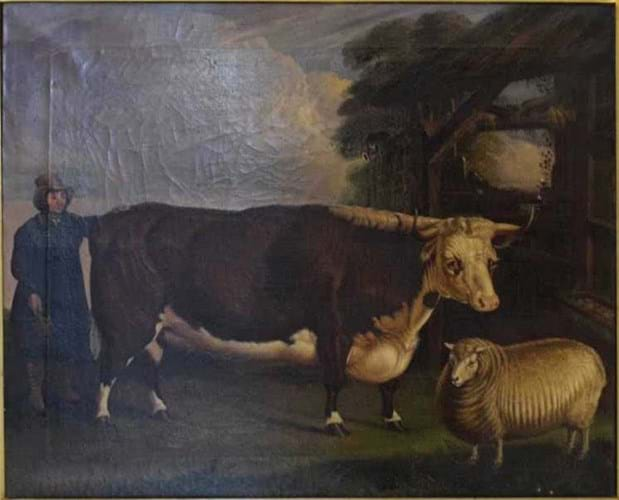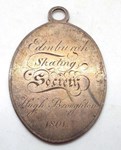Works with a naive charm but decorative appeal have been experiencing growing demand over recent years.
Often by unknown or itinerant artists, pictures in this slightly quirky sub-category of the art market have in some cases risen quicker in price than art by more established names from the same period.
As well as the way they capture elements of social history, buyers are attracted to these works as curios. More recently, greater appeal has been engendered thanks to their idiosyncratic decorative qualities that seems to sit well with modern tastes.
A few examples sold at auction in the last couple of months underlined this trend.
Little-known painter
Attracting attention at Clevedon Salerooms (22% buyer’s premium) on September 1 was a painting of prize shorthorn bull and a sheep by Lucas Beattie (fl.1830-40s).
Few works by the little-known artist are recorded as ever having sold at auction. One from 1833 depicting a bay racehorse called Moonraker emerged in 1993. Another was unsold at Bonhams Los Angeles in April 2021 – a painting from 1837 of a racehorse called Chit Chat which had been given a $3000-5000 estimate.
That pitch might have seemed rather high for an artist with almost no track record but, judging by the demand that emerged 18 months later across the Atlantic in Clevedon, perhaps it was not so ill judged.
According to Sally Mitchell’s 1985 reference book The Dictionary of British Equestrian Artists, Beattie was born in Wolverhampton and, as well as cattle, also painted horses and dogs. “His landscapes are good and very finished but his horses tend towards a slight flatness”, she commented. “However, he was able to depict his horses’ shiny coats with great ability.”
This bovine subject at Clevedon also showed enough painterly quality to suggest he operated at a level above the amateur or self-taught itinerant artists practising at the time. Indeed, it seems likely he was able to gain some significant commissions; the presence of the animal’s owner in this and other pictures reflecting that.
The 2ft 1in x 2ft 6in (63 x 75cm) oil on canvas, which was signed and dated 1833, came to auction from a deceased estate having previously been owned by a farming family in north Shropshire for whom the saleroom had already sold some standard ‘farmhouse’ furniture.
Showing a Hereford bull, it may well have been commissioned by the landowner after winning a prize at a local livestock show.
In terms of its condition, it had some major issues including two holes, scratches, flaking and the canvas sitting loose in the stretcher leading to a square outline a few inches inside the frame.
But, even in this state, the style and subject matter found appeal – buyers of these works prefer large animals with plenty of presence and rustic charm of which this was a good example and which, rarely, was signed by a known artist and dated.
Due to the condition and the previously unsold work at Bonhams, the auction house pitched it at £800-1200, a level that drew two strong commission bids including one from the specialist antiques (but not picture) trade. After further competition, it was knocked down at £5800 to a different bidder, a specialist gallery which is planning to restore it carefully.
Twenty years ago such a work would have done well to make a tenth of this price – a growth in value not seen for many 19th century pictures.
The result followed a portrait of a Longhorn cow by an unknown naive artist flying past a £200-300 estimate to make £7000 at Dominic Winter in March (see ATG No 2537).
House call
Another work with a certain naive element but more grand in subject matter posted the top price at Dreweatts (25% buyer’s premium) in Newbury on October 3.
Part of the collection formerly at Flaxley Abbey, a Grade I-listed property in Gloucestershire, the Anglo-Dutch English School painting of an unidentified country house dated from c.1740.
It had previously been part of the Messel family collection kept at Nymans House in West Sussex, until that burnt down in 1947, and then hung in the drawing room at nearby Holmstead Manor where the family relocated.
The collection at Flaxley Abbey had been specially designed or sourced by artist, interior designer and stage set producer Oliver Messel (1904-78) for the property’s owner, the industrialist Frederick Baden Watkins, over a period of 12 years.
Messel also supplied works he had inherited from his own family such as this 4ft 7in x 5ft 10in (1.4 x 1.8m) oil on canvas.
The view of the house and park with an oval pool and figures in the foreground was painted by an unknown hand. Although not perhaps a major work by a toprank artist, it still had plenty of architectural and topographical interest, capturing some of the estate’s key features such as the projecting pavilions set at angles of the square centre block.
The layout of the estate can be seen in some of the engraved plans by Italian architect Sebastiano Serlio (c.1475-1554), which became influential in England in the 17th century.
One candidate for the location depicted here was Thirlestane Castle in the Scottish Borders, the seat of the Dukes of Lauderdale, although, since it was remodelled and enlarged in the 1840s, no record exists of the previous layout of its formal garden.
The design of the landscape in the picture was also of interest to students of garden history. The auction house pointed out that it dated from “a period in which formal continental-style gardens were being swept aside to make way for Capability Brown’s vision of arcadia with elements of both clearly visible in the picture”.
Dreweatts’ head of house sales and private collections Joe Robinson said: “These types of large-scale parkland scenes are relatively rare and are enduringly popular with an appeal to a wide cross section of buyer.
“The subject matter and its scale ensured that it drew global interest from both academic and decorative bidders alike.”
While it had some visible repairs, scattered retouching and varnish to the surface, bidders did not baulk at the £7000-10,000 estimate. Bringing both trade and private interest, it drew good competition on the day and was knocked down at £30,000 to a phone buyer from the UK.
Messel made
Elsewhere at the Flaxley Abbey auction, a group of 11 framed sketches for stage sets and characters in costume by Messel himself all sold over estimate for a combined total of £18,300. The bidding was dominated by two private collectors.
Leading the pack was a design for the character Madam Malaprop in Richard Sheridan’s comedy The Rivals, for a production performed at the Criterion Theatre in 1945. Estimated at £1000-1500, the 19¾ x 13in (51 x 34cm) signed pencil, watercolour and gouache was pursued to £2800, a good price for a Messel costume design.















